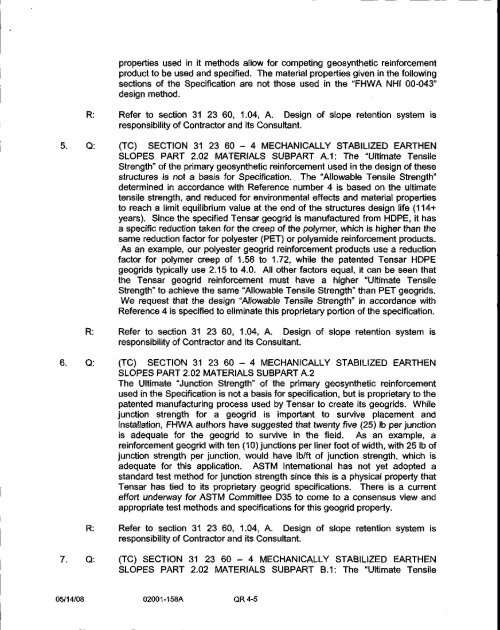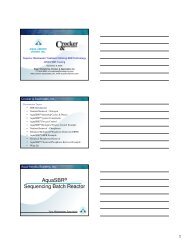Subcontractors
ADDENDUM X
ADDENDUM X
Create successful ePaper yourself
Turn your PDF publications into a flip-book with our unique Google optimized e-Paper software.
properties used in it methods allow for competing geosynthetic reinforcementproduct to be used and specified. The material properties given in the followingsections of the Specification are not those used in the "FHWA NHI 00-043"design method.R: Refer to section 31 23 60, 1.04, A. Design of slope retention system isresponsibility of Contractor and its Consultant.5. Q: (TC) SECTION 31 23 60 - 4 MECHANICALLY STABILIZED EARTHENSLOPES PART 2.02 MATERIALS SUBPART A.l: The "Ultimate TensileStrength" of the primary geosynthetic reinforcement used in the design of thesestructures is not a basis for Specification. The "Allowable Tensile Strength"determined in accordance with Reference number 4 is based on the ultimatetensile strength, and reduced for environmental effects and material propertiesto reach a limit equilibrium value at the end of the structures design life (114+years). Since the specified Tensar geogrid is manufactured from HDPE, it hasa specific reduction taken for the creep of the polymer, which is higher than thesame reduction factor for polyester (PET) or polyamide reinforcement products.As an example, our polyester geogrid reinforcement products use a reductionfactor for polymer creep of 1.58 to 1.72, while the patented Tensar HDPEgeogrids typically use 2.15 to 4.0. All other factors equal, it can be seen thatthe Tensar geogrid reinforcement must have a higher "Ultimate TensileStrength" to achieve the same "Allowable Tensile Strength" than PET geogrids.We request that the design "Allowable Tensile Strength" in accordance withReference 4 is specified to eliminate this proprietary portion of the specification.R: Refer to section 31 23 60, 1.04, A. Design of slope retention system isresponsibility of Contractor and its Consultant.6. Q: (TC) SECTION 31 23 60 - 4 MECHANICALLY STABILIZED EARTHENSLOPES PART 2.02 MATERIALS SUBPART A.2The Ultimate "Junction Strength" of the primary geosynthetic reinforcementused in the Specification is not a basis for specification, but is proprietary to thepatented manufacturing process used by Tensar to create its geogrids. Whilejunction strength for a geogrid is important to survive placement andinstallation, FHWA authors have suggested that twenty five (25) lb per junctionis adequate for the geogrid to survive in the field. As an example, areinforcement geogrid with ten (10) junctions per liner foot of width, with 25 lb ofjunction strength per junction, would have lb/ft of junction strength, which isadequate for this application. ASTM International has not yet adopted astandard test method for junction strength since this is a physical property thatTensar has tied to its proprietary geogrid specifications. There is a currenteffort underway for ASTM Committee D35 to come to a consensus view andappropriate test methods and specifications for this geogrid property.R: Refer to section 31 23 60, 1.04, A. Design of slope retention system isresponsibility of Contractor and its Consultant.7. Q: (TC) SECTION 31 23 60 - 4 MECHANICALLY STABILIZED EARTHENSLOPES PART 2.02 MATERIALS SUBPART B.A: The "Ultimate Tensile05114108 02001-158A QR 4-5



